
Graduate Nurse Recruitment
Increasing the recruitment of graduate nurses at UVMHN
PROBLEM
As a health network, there has been a decline in the expected number of graduate applicants from regional schools and subsequently the recruitment of graduate nurses to the Partner hospitals.
OUTCOME
Network Preceptor Professional Development Program: An important outcome of this work was an understanding about the importance of effective nurse preceptorship for recruitment and retention of graduate nurses and the need to improve consistency across UVMHN amongst current and future preceptors.
Project Overview
In 2023-24, hiCOlab worked with the CNO leadership team to identify opportunities for improving graduate nurse recruitment and retention. With the goal of increasing the number of graduate nurses who apply to (and then accept positions) at the UVM Health Network and its Partner organizations.
Team: Jewel Thompson-Adiuku, Sam Grise, Jeremy Beaudry
Sector: UVMHN FY24 Objective of “Attract and retain an engaged workforce”
Related Key Result: Reduce Time to Fill for ‘active’ open roles below 90 days.
Role: Design Research, Project Management

Picture taken by team preceeding ethnographic research at Dell Children's Medical Center.
This case study will share the human-centered design process and how that methodology informed our user-centered research with nursing students, new nurses, and staff to generate key insights about their needs. I also explain the facilitation design, which was instrumental in guiding the direction of this work. There were many insights generated from this work that were instrumental in informing the graduate nurse recruitment strategy for FY24.
Approach
-
Problem Exploration Workshop – Develop the goals of the research
-
Literature Review – Reviewing a breadth of existing literature and studies to better understand the current landscape and goals of the research.
-
Nursing student survey – Conducted a survey completed by nursing students in the Vermont and New York region consisting of rank order, open-ended, and likert scale questions.
-
72 responses; ranging from age 19-45 and older; 12 nursing schools
-
-
Semi-structured interviews – Conducted interviews over two months to understand the experience of nursing students, new nurses, and UVMHN Partner staff during recruitment.
-
48 interview participants; 7 nursing schools; 7 Partnering hospitals
-

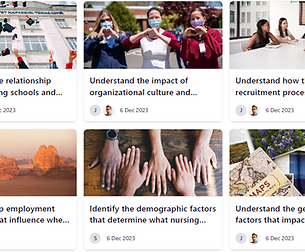

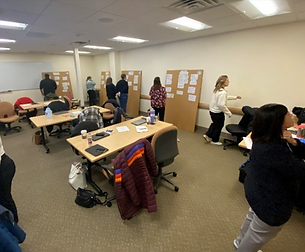
🔍 Defining the Problem
Problem Exploration Workshop
This problem is a strategic priority as it directly relates to the organizational objective of UVMHN Experience to attract and retain an engaged workforce. This space is dynamic with many different complexities, surrounding schools, generational differences, diverse processes and even the housing crisis.
We started with a facilitated workshop to define the problem and help the team build a shared understanding of why this problem is important to solve. From this work, leadership team members identified 3 desired impacts to come out of this work:
-
Increase the number of local graduate nurses hired at partners – who are well-trained and appropriately placed – thereby decreasing reliance on (and cost of) contingency labor (ie. Travel nurses)
-
The Network’s relationship with regional schools can be stronger.
-
Suboptimal clinical experiences for nursing students may be impacting recruitment e.g. experiences that are negative, too late in the curriculum, or too few.
-
Generational perspectives about “career” and goals need to be better understood.
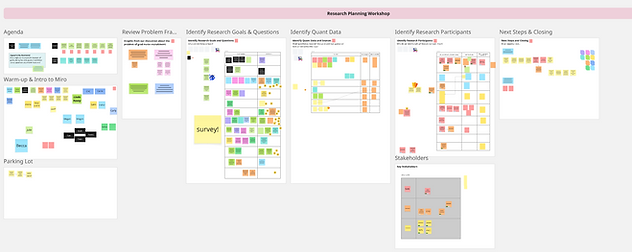
Picture of the Miro board used by the research team to plan the research.
🔍 Key Insights
Research Goals:
1) Understand the relationship between nursing schools and UVMHN and how it impacts GN applications.
2) Identify the top employment motivations that influence where a GN applies.
3) Understand the impact of organizational culture and reputation on GN applications.
4) Understand how the current recruitment process is experienced by GNs and identify ways to improve it to eliminate existing barriers.
5) Understand the geographic factors that impact where a GN applies.
6) Identify the demographic factors that determine what nursing schools GNs apply to.
Discussion about the current recruitment efforts and experience of nursing students and new nurses interacting with UVMHN Partners yielded several key insights. These insights are a cumulation of all the conversations we had with nursing students, new graduate nurses, and UVMHN Partner staff.
The data that resulted from these interviews were organized using the Employee Value Proposition (EVP) wheel:
Compensation | Benefits, Career, Work Environment, Recruitment | Nursing Students & Schools, Culture.
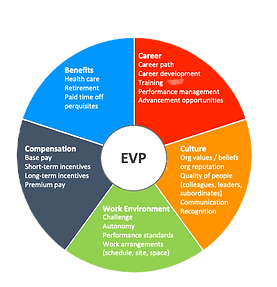
Picture of the Employee Value Proposition (EVP) wheel An EVP is the set of benefits an organization offers employees in return for their skills, experience, and qualities they bring to the position. This provides a framework for how the insights should be reviewed by the CNO leadership team.
Our Research Findings:
Career
Preceptors seek support in training new nurses and nursing students during their orientation and onboarding. Their ability to build relationships with and confidence of their preceptees is related to the level of support they receive from their employer in the area of professional preceptor training, additional compensation, and workload redistribution.
01. Staff shortages and high turnover shrink the pool of qualified preceptors, resulting in high rates of burnout, relying on less experienced or travel nurses as preceptors, and diminishing the learning experience.
02. Incentives and workload distribution can make the preceptor role more appealing and manageable for staff members.
"In terms of preceptor development it comes down to [we have a] small pool to pick from. [We] end up picking the same [staff] every time and that does get tiresome. I know that some of our best preceptors were not in a mental space to take another new grad this past year. So some of our best preceptors we weren't able to [use this time]. And part of that is just taking care of [our] preceptors."
- Nurse Educator [CH.0248]
03. Expert preceptors and standardized training programs can improve consistency, reduce errors, and enhance patient safety during clinical placements.
"Need more internal consistency around the development of preceptors to ensure that nursing students are getting the same information and experience regardless of the hospital they are completing their clinical placement."
- Nurse Educator [CH.0242]
04. Clearer guidelines are necessary for nurse educators to clarify their roles and ensure effective collaboration with schools and clear expectations for new nurses.
“I had two main preceptors but quite honestly, they weren’t always available. So I had, probably two or three other nurses endedup having [to] precept occasionally. The problem with having multiple preceptors ist hat everybody has a different way of doing things. And that’s a good thing because you see different ways of doing it, but sometimes I feel like as anew grad nurse, you kinf of just want to do it one way until you really get it, rather than learning five different ways…. So having multiple preceptors can be difficult. It worked ok for me, but I wouldn’t necessarily recommend it for everybody.”
– Graduate Nurse [RG.1785]
Solution
How Might We ...
HMW prioritize our commitment to personal fulfillment for our preceptors in order to ensure active engagement to teach our nurses?
How Might We ...
HMW improve the preceptor experience for our new nurses and preceptors in order to create belonging, inclusivity, understanding, the value of the role, and enhanced retention?
How Might We ...
HMW foster growth and development for our preceptors in order to elevate the expertise of the role?
How Might We ...
HMW create a preceptor program for new nurses in order to make the onboarding process more valuable to increase retention and enhance employee experience?
Network Preceptor Professional Development Program
-
A team of preceptors who float throughout the hospital.
-
Consistent preceptor program that holds people accountable, promotes the value and benefit of being a preceptor, includes check-ins, celebrations, what to expect, balancing assignments equitably.
-
Provides opportunities for continued learning, engagement, time balance (instead of being part of the staffing mix); may be segmented by NY and VT due to licensing.
-
Standardization of preceptorship across UVMHN Partners will help create equity around graduate nurse and nursing student experience, and appropriately set clear expectations of preceptorship.
-
Ongoing preceptor training and support that will lead to willingness to precept, increased confidence of preceptors and their preceptee, and decreased burnout.
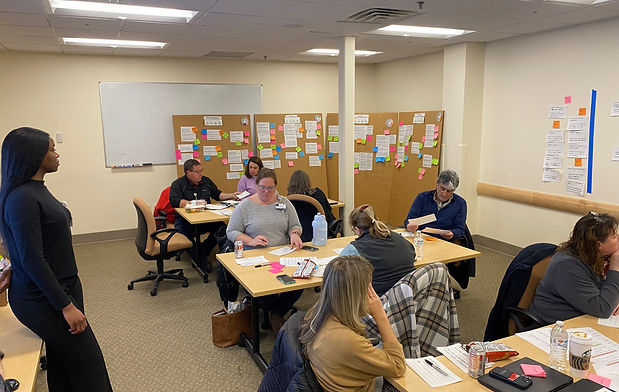.jpeg)
Image of Chief Nursing Officers (CNOs) at each of the UVMHN Partner hospitals developing solutions.
💭 Reflection
Project Takeaways
The UVM Health Network is a complex system made up of various hospitals. Understanding the differences in nursing practices at each Partner hospital was crucial to the development of solutions that will have a lasting impact on the organization as we move towards being a more unified system.
